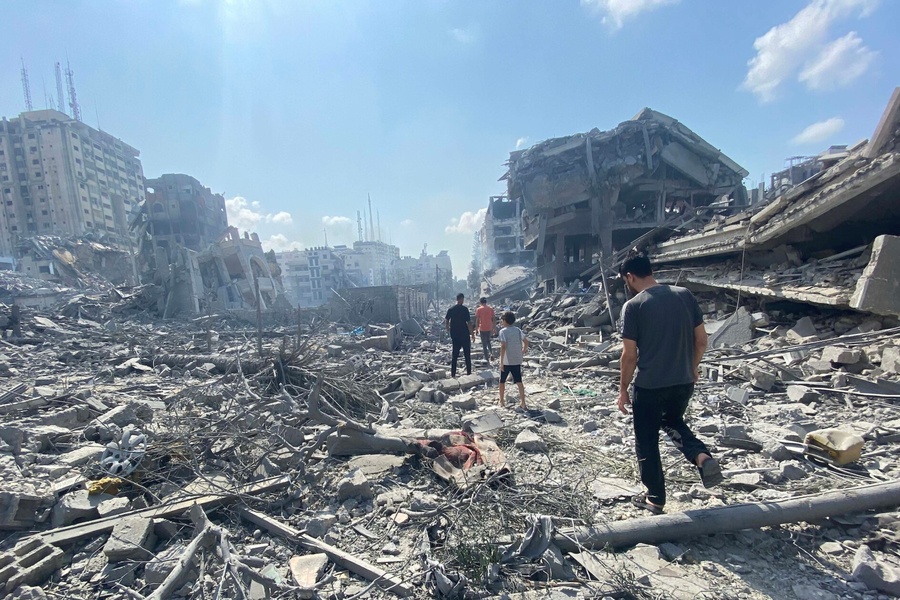Strikes in Syria: The International Law Framework
[Cross-posted at Just Security]
As is now well-known, the United States last night hit approximately 25 targets inside Syria, some of which were directed at ISIL, and some at a group that has only recently been brought to the public’s attention – the Khorasan Group, which is
Published by The Lawfare Institute
in Cooperation With

[Cross-posted at Just Security]
As is now well-known, the United States last night hit approximately 25 targets inside Syria, some of which were directed at ISIL, and some at a group that has only recently been brought to the public’s attention – the Khorasan Group, which is reportedly comprised of al Qaeda militants and led by senior al Qaeda officials from among Usama bin Laden’s inner circle. According to a letter submitted by the United States to the United Nations on Tuesday, the Administration is justifying the strikes against ISIL as a lawful exercise of collective self-defense of Iraq. The letter then goes on to state that the strikes against the Khorasan Group “address terrorist threats that they pose to the United States and our partners and allies.”
As the letter suggests, the legal justification for strikes against ISIL is presumably not the same as that for strikes against Khorasan. The following unpacks some of the key differences. (See also Ashley Deeks here and here and Ryan Goodman here and here for analysis of some of these issues.)
Collective Self-Defense and ISIL
The U.S. government received a letter from the Iraqi government explicitly asking for U.S. help in the fight against ISIL, thus supporting a claim of collective self-defense. According to the U.S. notification to the United Nations, Iraq has specifically requested that the United States lead international efforts to strike ISIL sites inside Syria to suppress continuing attacks on Iraq and protect Iraqi citizens. Under a theory of collective self-defense, the United States is assisting Iraq in responding to the direct and ongoing threat posed by ISIL; the threat stems in part from ISIL forces in Syria; and Syria is either unable or unwilling to quell the threat, thereby justifying an incursion into Syria’s territory.
The weakest link in the chain is the unwilling or unable test. As one of us has written, “The ‘unwilling or unable’ test is now a fairly well settled part of the US government’s legal position. Nevertheless, it remains controversial under international law.” And another one of us conducted an exhaustive study which found that states quite frequently invoke the test, but “found no cases in which states clearly assert that they follow the test out of a sense of legal obligation.” That said, Secretary General Ban Ki-moon’s statement today which emphasized that the “the strikes took place in areas no longer under the effective control of that Government,” suggests there may be growing acceptance for aspects of at least the “unable” prong of the test in some cases.
Assuming, arguendo, acceptance of the unable or unwilling test, the U.S. legal argument is sound, so long as the force used is necessary to protect against the direct threat that ISIS poses to Iraq, and that the amount and nature of force is proportionate to suppressing that threat. Given ISIL’s rapid advances in Iraq, given claims that planning and support is flowing from Syria, and given Assad’s inability (and potential unwillingness) to quell ISIL operations along the Iraq border, the necessity of the actions seems clear. Targeted strikes against ISIL bases, ISIL training camps, and ISIS-controlled transit points into Iraq seem proportionate to this aim.
If the goal shifts from defending against, repelling, or containing ISIL to destroying ISIL (as President Obama has previously stated is its ultimate goal), this legal ground becomes shakier. The United States (and Iraq) will need to establish that the destruction of the group is necessary and proportionate to the threat – something it very well may do, but which will likely raise questions about proportionality.
Defense of U.S. Nationals and ISIL
According to New York Times reporting, the United States may also be relying on a theory of defense of U.S. nationals in Iraq as a supplementary justification for uses of force against ISIL. (Given repeated statements that ISIL does not currently pose a specific, threat to the U.S. homeland, the theory of self-defense needs to be instead based on threats to U.S. personnel.) But this is a less convincing rationale—and notably is absent from the final letter submitted to the U.N.
Given that the United States has successfully defended against ISIL advances that would have directly threatened U.S. personnel in Iraq, and given that the United States has not deemed it necessary to evacuate non-military U.S. personnel for their safety, it seems questionable that further attacks in Syria are, at least at the moment, necessary to protect U.S. personnel. (That said, none of us is privy to the relevant intelligence, so it is of course possible that there is information suggesting ISIL in Syria has both the capacity and intent to launch attacks targeting U.S. personnel in Iraq, which would obviously change the calculus.)
This claim, moreover, raises another issue – one that international law does not currently resolve, but that warrants further consideration. The U.S. could, of course, minimize this threat by removing personnel from Iraq. In what situations should a nation’s decision to keep its personnel in a risky environment itself provide the justification for use of force? An obligation to remove personnel sounds, in some ways, like a forced retreat – and not something that international law should demand. On the other hand, a nation should not be permitted to purposefully place its personnel in an inherently risky situation and then claim self-defense as an end-run around rules limiting the use of force.
In any event, the claim of collective self-defense appears a much sounder claim than one based on defense of U.S. nationals.
Collective Self-Defense and Khorasan?
Little was known about the Khorasan Group until earlier last week, when Administration officials first began publicly talking about the threat posed by this group. Most claims with respect to Khorasan focus on the threat allegedly posed to U.S. and European allies. In that same vein, the U.S. letter to the U.N. states that the strikes against Khorasan “address terrorist threats that they pose to the United States and our partners and allies.”
There is thus no indication that the United States is undertaking attacks against Khorasan with the aim of coming to Iraq’s defense or that the Iraqis have requested the U.S. to take action against Khorasan. As for European allies: under the rules of collective self-defense, at least as articulated by the ICJ, those allies (at least one of them) would have to invoke the right of self-defense against an imminent threat of armed attack from Khorasan and formally request the assistance of the United States to use force against the group.
Possible Theories Justifying Strikes Against Khorasan
What, then, justifies the strikes against Khorasan? In a War Powers Report filed today, President Obama invokes (among other things) his authority to carry out strikes pursuant to the 2001 AUMF. This suggests that the United States is relying on the theory that Khorasan is either “part of” al Qaeda or an “associated force” thereof. Indeed, the WPR describes Khorasan as an “element” of al Qaeda. Under this theory, the U.S. is in an ongoing armed conflict with Khorasan; Syria is unable or unwilling to take action against our enemy in the armed conflict; and thus the United States may use force in Syria against Khorasan without having to undertake a new self-defense analysis to justify the incursion into Syrian territory. This, after all, is what John Brennan argued when he asserted the right to take action against al Qaeda “without doing a separate self-defense analysis each time.”
That said, this is not likely to be a popular position, at least internationally. The United States entered an armed conflict with al Qaeda in late 2001, under a well-accepted theory of self-defense, and initially took action against al Qaeda in Afghanistan with the blessing of the international community. Now, thirteen years later, it is not entirely clear that the same blessing supports a continuing armed conflict model against associated and splinter groups—especially if that theory is used to intervene militarily in another nation’s territory without its consent.
The United States may also be separately asserting a claim of anticipatory self-defense. The Pentagon today seemed to lay the framework for that position, stating that Khorasan was “nearing the execution stage of launching at attack on Europe or the homeland.” If there is reliable information suggesting that Khorasan is planning active, direct attacks on the homeland, then strikes against Khorasan may very well be justified under a theory of self-defense, again assuming one accepts the unwilling or unable test and can establish that Syria meets that standard. Whether the situation squarely falls within a self-defense theory depends on multiple unknown facts, including what the Pentagon means by “nearing the execution stage.” We simply lack intelligence information to assess how credible or imminent such a threat is – essential components to any assessment of the necessity and proportionality requirements of self-defense.
All of this, of course, is focused on the international law issues, and does not assess the domestic law basis for the strikes. As for the domestic law basis, the administration again appears to be invoking the 2001 and 2002 AUMFs – a position that two of us have been critical of in the past. We thus join President Obama in his call to Congress to put the actions on sounder domestic law footing, and pass a new authorization specifically focused on ISIL, and, depending on the facts, the Khorasan Group as well.
***
Guest Author Ryan Goodman is co-editor-in-chief of Just Security. He is the Anne and Joel Ehrenkranz Professor of Law and Co-Chair of the Center for Human Rights and Global Justice at New York University School of Law, and he is also Professor of Politics and Professor of Sociology at NYU.
Ashley Deeks is the Class of 1948 Professor of Scholarly Research in Law at the University of Virginia Law School and a Faculty Senior Fellow at the Miller Center. She serves on the State Department’s Advisory Committee on International Law. In 2021-22 she worked as the Deputy Legal Advisor at the National Security Council. She graduated from the University of Chicago Law School and clerked on the Third Circuit.
Jen Daskal is a Partner at Venable LLP. She is a national security legal and policy expert, with years of experience managing crisis, mitigating risk, and working at the intersection of technology, policy and law. From October 2023 to January 2025, Daskal was the Deputy Homeland Security Advisor at the White House. She also previously served as the Principal Deputy Legal Advisor at the National Security Council, Acting General Counsel at the Department of Homeland Security, and counsel to the Assistant Attorney General for National Security at the Department of Justice. She has written extensively on issues of data security and data privacy, testified multiple times before Congress, and published numerous journal articles and op-eds.
More Articles
-

Inside Trump’s Second-Term National Security Strategy
President Trump’s new “America First” National Security Strategy (NSS) is a stark departure from previous strategies. -

Why Gaza’s Aid Effort Will Fail Without Cash
Israel’s economic warfare and the hidden monetary and financial roots of Palestine’s humanitarian crisis. -

Lawfare Daily: Scott Anderson on How Social Media Platforms Should Handle Unrecognized Regimes
How should social media platforms handle unrecognized regimes like the Taliban?


.jpg?sfvrsn=11cea85a_3)



